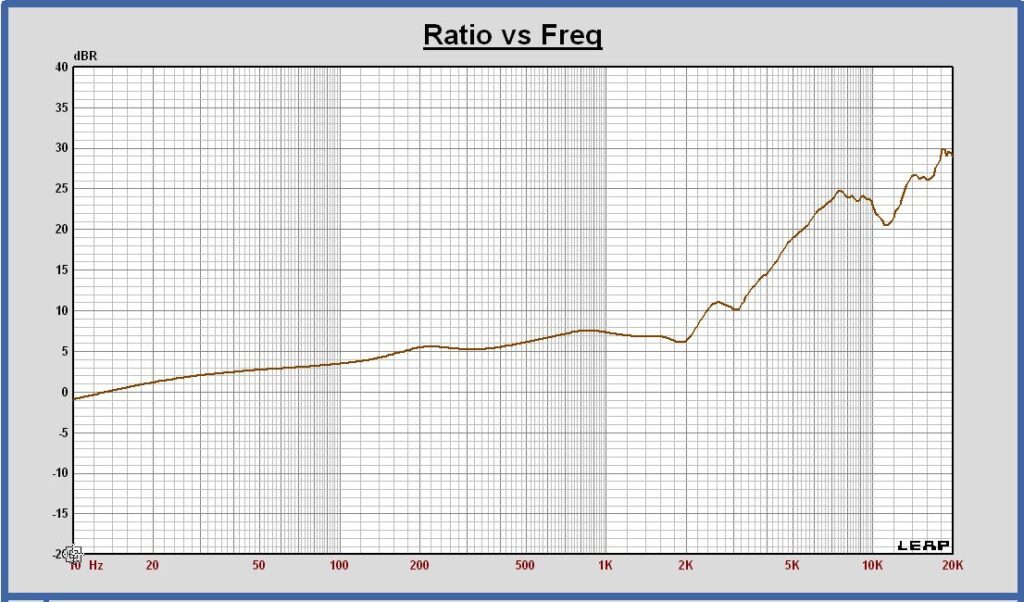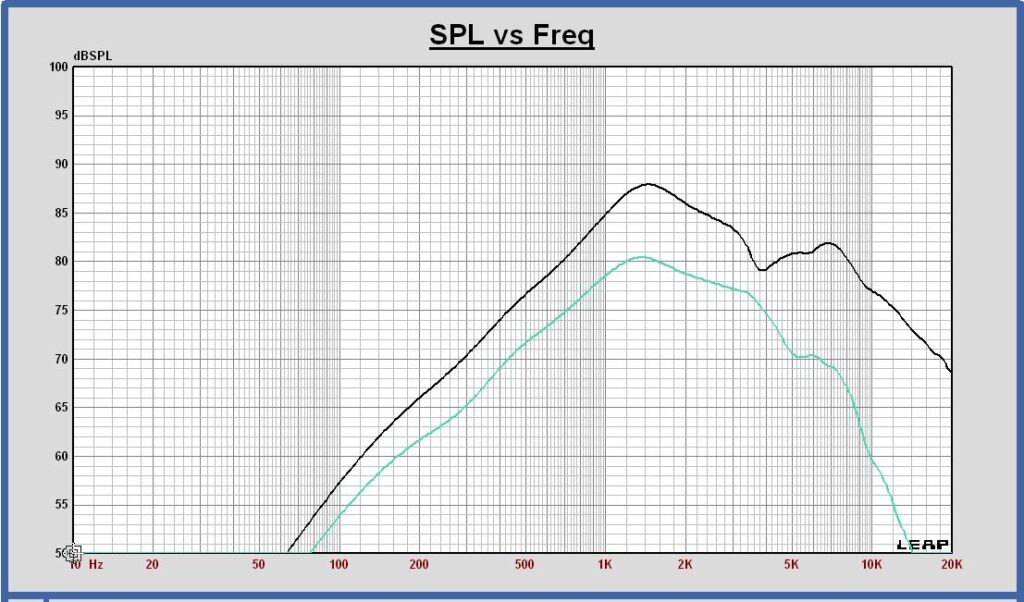4-way full range dipole speaker with AE woofer, Supravox lo-midrange, Scanspeak hi-midrange and Mundorf AMT dipole tweeter

- The VCL EX22 is a 4 – way full range dipole loudspeaker.
- Three different systems will be designed for this loudspeaker, a passive system with analog filtering using discrete components, an active system with analog filtering using opamps or tubes and an active system with digital filtering using biquads.
- The transducers are the Audio Elegance Dipole 18 – D8 as woofer, the Supravox 215 RTF 64 as lo – midrange, the Scanspeak 12MU/4731T00 as hi – midrange and the Mundorf AMT17D2.2 as tweeter.
- The total speaker is 109 cm high and 50 cm wide. The loudspeaker foot is 42 cm deep.
- The speaker sensitivity is 83 dB at 1m, 2.83 Vrms, full space, the low frequency response F3 = 33 Hz and for a woofer maximum excursion condition at 33 Hz the speaker maximum SPL is 101 dB @ 33 – 20000 kHz at 1m, free space.
Contents
- Specification Headlines
- Estimation Bill Of Material
- Transducers
- Cabinet
- Dipole radiation behavior of the transducers in the cabinet
- Woofer Dipole
- Lo – midrange Dipole
- Hi – midrange Dipole
- Tweeter Dipole
- Active Digital Crossover filter
- Maximum excursion and maximum SPL with crossover filter
Specificaton Headlines
- System: 4-way full range dipole with an analog passive, an analog active or a digital active X-over
- Woofer: AE Dipole 18-D8
- Lo – midrange: Supravox 215 RTF 64
- Hi – midrange: Scanspeak 12MU/4731T00
- Tweeter: Mundorf AMT17D2.2
- Low frequency response: F3 = 33 Hz
- Sensitivity: 83 dB at 1m, 2.83 Vrms, full space
- SPL at maximum excursion, 33 – 20000 Hz: 101 dB, 1m, full space
- Crossover: Linkwitz – Riley 4th order or Elliptical 3rd order at 250, 1000 and 4000 Hz
- Impedance: tbd
- Baffle dimensions with foot: width x heigth x depth = 50 cm x 109 cm x 4 cm
Estimation Bill Of Material
- 2 x Woofer AE Dipole 18-D8: 964 euro ex. transport and taxes
- 2 x Lo – midrange Supravox 215 RTF 64: 518 euro
- 2 x Hi – midrange Scanspeak 12MU/4731T00: 580 euro
- 2 x Tweeter Mundorf AMT17D2.2: 538 euro
- Components high quality analog passive crossover: 1000 euro
- Components medium quality analog passive crossover: 625 euro
- Cabinet material: 100 euro
- Cabinet Accessoires: 100 euro
- Total with high quality crossover 3800 euro
- Total with medium quality crossover 3425 euro
Transducers

AE Dipole 18-D8, Supravox 215 RTF 64, Scanspeak 12MU/4731T00, Mundorf AMT17D2.2
For the woofer we have chosen for a large 18 inch transducer, the AE Dipole 18-D8. It is specially designed for dipole applications and if placed in a 50 cm wide open baffle it can be used up to 250 Hz as a dipole configuration without any problem. With its high sensitivity of 96.5 dB @ 2.83 Vrms, 1m and its high maximal lineair excursion of 15 mm peak, it is very suitable to be used in this 4 way dipole loudspeaker.
As lo – midrange the 8 inch Supravox 215 RTF 64 is chosen. This full range transducer is used in studios and well known for its clear and precise medium frequency sound. The sensitivity is 98 dB at 2.83 Vrms, 1m which makes this transducer very suitable to take over at 250 Hz. Placed in a very small open baffle this transducer can operate as a dipole up to 1000 Hz.
As hi – midrange the 3.5 inch Scanspeak 12MU/4731T00 will be used. This small midrange with an effective cone diameter of 8.5 cm can operate up to 4 kHz as a dipole, if it is placed in a very small baffle. The sensitivity is 90 dB at 2.83 Vrms, 1m. The harmonic distortion of this transducer is low, better than – 50 dB between 300 and 10000 Hz with a peak of – 43 dB at 1500 Hz.
The Mundorf AMT17D2.2 is an AMT dipole tweeter. The radiating surface Sd = 12 cm2. The diaphragm is about 25 mm wide and 50 mm high. The harmonic distortion of this transducer is low, better than -40 dB between 2700 and 20000 Hz. The transducer can be used as a dipole tweeter without baffle. The tweeter flange is 60 mm wide and 60 mm high.
Cabinet
Cabinet dimensions

To make a stable construction the woofer baffle thickness will be chosen about 44 mm. The midrange – tweeter baffle is only 18 mm, to keep the path from the back side to the front side of the baffle for the midranges and the tweeter as short as possible. It is important to guarantee a good dipole behavior, especially for the hi-midrange and the tweeter.
The baffle is mounted on a foot. A box for a passive filter or an active system can be mounted on the backside of the foor. It also makes the foot more heavy and stable.
Dipole radiation behavior of the transducers in the cabinet
Some study has been done to investigate the dipole radiation behavior of the transducers in the cabinet. On and off axis SPL responses have been simulated and the polar diagram, the power response and the direcivity index are considered in detail.
For a good dipole behavior in the total frequency range, the polar diagram has to be uniform conform the dipole characteristics and the directivity index (DI) has to be about 4.7 dB and as flat as possible versus frequency.
To calculate the power response and directivity index, the horizontal and vertical SPL off axis responses of the woofer, the two midranges and the tweeter are simulated in steps of 15 degrees, the speaker placed in a full sphere at 3m distance. The power is calculated out of the mean value of these curves. The power is represented as the SPL of an omnidirectional source at 3m distance in a full sphere with a SPL value equal to the power.
To guarantee a good dipole behavior of all the transducers in their operating frequency range, the baffle size is chosen as small as possible w.r.t. the transducer frame dimensions.
Woofer Dipole
For the frequencies up to 250 Hz, a 18 inch woofer is chosen. The transducer frame dimension is 47.2 cm, the baffle width is 50 cm.
SPL on axis and horizontal off axis 15 30 45 60 75 90 degrees at 3m, 2.83 Vrms in full sphere

Horizontal polar diagram 80 – 160 – 320 – 640 – 1280 Hz at 3m in full sphere

The vertical off axis curves and the vertical polar diagram are the same as the horizontal off axis curves and polar diagram in free space, as the baffle is a square.
SPL on axis and the power at 3m, 2.83 Vrms in full sphere

Directivity Index at 3m in full sphere

- the woofer off axis SPL shows a good dipole behavior up to 700 Hz. The directivity index is about equal to the expected 4.7 dB of an ideal dipole up to 200 Hz. Above 200 Hz some DI increase can be observed caused by the baffle dimensions.
- the horizontal polar diagram shows a good dipole behavior up to 320 Hz. Above 300 Hz some beaming of the 18 inch woofer can be observed.
- as a conclusion of these simulations, this dipole woofer can be used up to 250 Hz in this 4 way system without any problem.
Lo – midrange Dipole
To cover the frequency range of 250 to 1000 Hz, an 8 inch midwoofer is chosen. The transducer frame dimension is 22.4 cm, the baffle is as small as pôssible with rounded edges as can be seen in the cabinet drawings.
SPL on axis and horizontal off axis 15 30 45 60 75 90 degrees at 3m, 2.83 Vrms in full sphere

Horizontal polar diagram 160 – 320 – 640 – 1280 – 2560 Hz at 3m in full sphere

SPL on axis and vertical off axis 15 30 45 60 75 90 degrees at 3m, 2.83 Vrms in full sphere

Vertical polar diagram 160 – 320 – 640 – 1280 – 2560 Hz at 3m in full sphere

SPL on axis and the power at 3m, 2.83 Vrms in full sphere

Directivity Index at 3m in full sphere

- the lo – midrange off axis SPL shows a good dipole behavior up to 1500 Hz.
- above 400 Hz the directivity index is higher than the expected 4.7 dB value of a dipole. It is caused by the baffle width in that frequency range.
- the horizontal and vertical polar diagrams show a very good dipole behavior up to minimum 1300 Hz.
- as a conclusion of these simulations, this dipole lo – midrange can be used up to 1000 Hz in this 4 way system.
Hi – midrange Dipole
For the frequency range of 1000 to 4000 Hz, a 3.5 inch transducer is chosen. The frame dimension is 12 cm, the baffle width as small as possible.
SPL on axis and horizontal off axis 15 30 45 60 75 90 degrees at 3m, 2.83 Vrms in full sphere

Horizontal polar diagram 320 – 640 – 1280 – 2560 – 3840 – 5120 Hz at 3m in full sphere

SPL on axis and vertical off axis 15 30 45 60 75 90 degrees at 3m, 2.83 Vrms in full sphere

Vertical polar diagram 320 – 640 – 1280 – 2560 – 3840 – 5120 Hz at 3m in full sphere

SPL on axis and the power at 3m, 2.83 Vrms in full sphere

Directivity Index at 3m in full sphere

- the hi – midrange off axis SPL shows a good dipole behavior up to 3000 Hz.
- above 700 Hz the directivity index is higher than the expected 4.7 dB value of a dipole. It is caused by the baffle width in that frequency range.
- the horizontal and vertical polar diagrams show a good dipole behavior up to 3000 Hz.
- the directivity index shows a dip above 3 kHz, which means that the radiation is more omnidirectional in that frequency region, but still acceptable to be used in this dipole system up to 4000 Hz.
- as a conclusion of these simulations, this dipole hi – midrange can be used up to 4000 Hz in this 4 way system.
Tweeter Dipole
The Mundorf AMT17D2.2 dipole tweeter is chosen. It is a dipole design and very small, interesting to realize a dipole at high frequencies. The outer flange dimensions of this tweeter are 60 x 60 mm. The tweeter baffle width is chosen also 60 mm.
SPL on axis and horizontal off axis 15 30 45 60 75 90 degrees at 3m, 2.83 Vrms in full sphere

Horizontal polar diagram 2560 – 3840 – 5120 – 6400 – 12800 Hz at 3m in full sphere

SPL on axis and vertical off axis 15 30 45 60 75 90 degrees at 3m, 2.83 Vrms in full sphere

Vertical polar diagram 2560 – 3840 – 5120 – 6400 – 12800 Hz at 3m in full sphere

SPL on axis and the power at 3m, 2.83 Vrms in full sphere

Directivity Index at 3m in full sphere

The DI decrease below 300 Hz is caused by a simulation artifact. At low frequencies the DI is constant and equal to 4.7 dB.
- the tweeter off axis SPL shows a good dipole behavior up to 6500 Hz. Around 8 kHz the radiation becomes more omnidirectional. Off axis there is a SPL peak around 8 kHz. The SPL dip at 3 kHz seems to be a simulation artifact, it must be checked with the measurements.
- up to 6.5 kHz the directivity index is 5.5 dB, a little higher than the expected 4.7 dB value of a dipole. This rise is caused by the tweeter frame finite dimensions in way it behaves as a little baffle.
- the horizontal and vertical polar diagrams show a good dipole behavior up to 6500 Hz.
- as a conclusion of these simulations, this dipole tweeter can be used above 4000 Hz in this 4 way system.
Active Digital Crossover filter
A Linkwitz-Riley 4th order crossover filter is designed. To realize flat curves for SPL, power and directivity index and to realize the best overall dipole behavior versus frequency, the crossover frequencies are chosen at 250, 1000 and 4000 Hz.
The crossover filter is designed using analog functional blocks. For this digital design the blocks are transformed to digital biquads that can be programmed on a digital platform, like miniDSP for example.
Crossover filter targets LR4 at 250, 1000 and 4000 Hz

Crossover filter schematic with functional blocks

woofer filter: 6 blocks; lo – mid filter: 7 blocks; hi – mid filter: 6 blocks and tweeter filter: 4 blocks.
SPL on axis of the filtered drivers and the sum at 1m, 2.83 Vrms

SPL horizontal off axis of the sum at 0 , 15, 30, 45 and 60 degrees at 3m, 2.83 Vrms

Power response of the filtered drivers and the sum in free space at 3m, 2.83 Vrms

Directivity Index in free space of the filtered drivers and the sum

The total DI curve shows that this loudspeaker has a dipole radiation behavior up to 7 kHz. Around 8 kHz there is a DI dip due to a more omnidirectional behavior of the tweeter. Between 300 and 7000 Hz the DI is higher than the theorical dipole DI value of 4.5 dB. It is caused by some beaming caused by the transducer baffles. The DI deviation is reduced to a minimum by choosing the baffles as small as possible for each transducer.
Maximum excursion and maximum SPL with the LR4 filter
Maximum excursion
With the designed Linkwitz – Riley 4th order filter, the woofer has a maximum excursion of 15.0 mm peak at 33 Hz for a voltage of 23.2 Vrms at the input of the filter.
The excursion of the lo – midrange, the hi – midrange and the tweeter have been calculated also at 23.2 Vrms.
Excursion at 23.2 Vrms of woofer (blue), lo – midrange (brown), hi – midrange (green) and tweeter (red)

The lo – midrange excursion is maximum at 191 Hz and equal to 0.321 mm peak.
The maximum specified linear excursion of the Supravox 215RTF 64 8 inch is 2.3 mm peak.
The hi – midrange excursion is maximum at 673 Hz and equal to 0.034 mm peak.
The maximum specified linear excursion of the Scanspeak 12MU/4731T00 inch is 3.5 mm peak.
The tweeter excursion is maximum at 4194 Hz and equal to 0.005 mm peak.
The maximum linear excursion of the Mundorf AMT17D2.2 is not specified.
Maximum SPL
The maximum SPL for the operating frequency range 33 – 20000 Hz at maximum excursion of the woofer is 101 dB at 1m, 23.2 Vrms at the input of the crossover filter.
